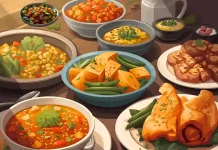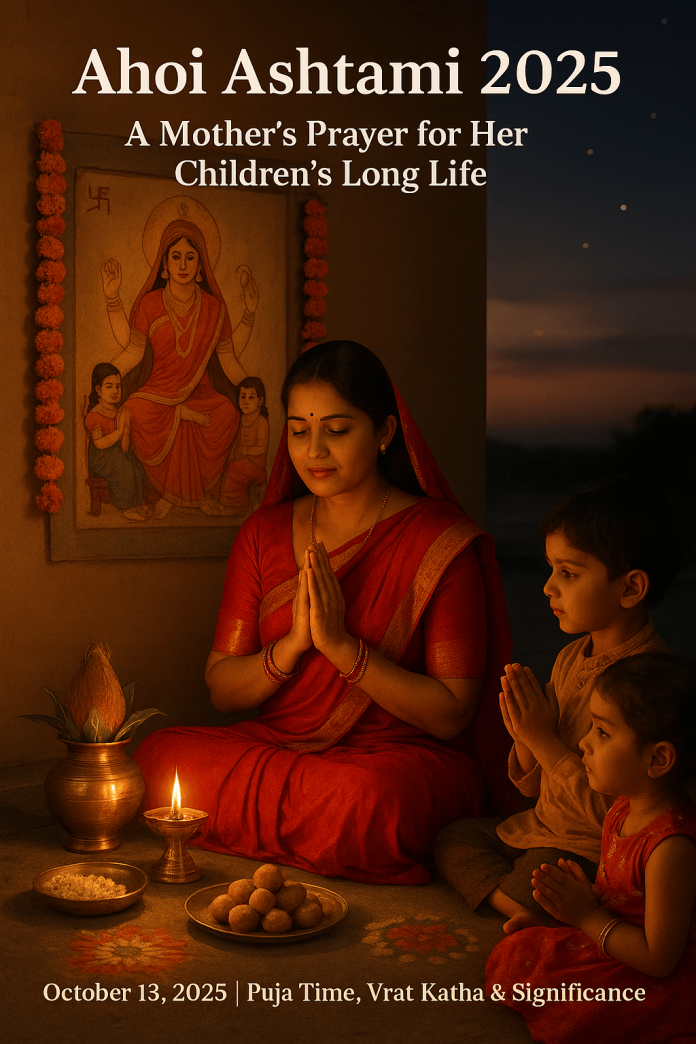As the festive season of 2025 approaches, Indian households prepare to celebrate one of the most heartfelt and spiritually rich observances — Ahoi Ashtami. Celebrated primarily by mothers, this sacred day is dedicated to the health, happiness, and longevity of their children.
Falling just a few days before Diwali, Ahoi Ashtami carries deep emotional and cultural significance, symbolizing the eternal bond between a mother and her child. Let’s explore the date, rituals, legends, and spiritual meaning of Ahoi Ashtami 2025 in full detail.
What Is Ahoi Ashtami?
Ahoi Ashtami (अहोई अष्टमी) is a Hindu festival of motherhood and protection, observed on the eighth day (Ashtami tithi) of the Krishna Paksha (waning moon phase) in the month of Kartik.
It is primarily observed in North India — especially in Delhi, Uttar Pradesh, Haryana, Punjab, and Rajasthan — though the devotion and meaning behind it resonate with mothers across the country.
On this day, mothers observe a fast (vrat) for the welfare, good health, and long life of their children. The fast begins before sunrise and continues until the sighting of stars or the moon at night.
Traditionally, the goddess Ahoi Mata, an incarnation of Goddess Parvati, is worshipped. She is believed to protect children from misfortune and bless families with prosperity and peace.
Ahoi Ashtami 2025 Date and Muhurat
According to the Hindu Panchang, Ahoi Ashtami in 2025 will be observed on Monday, October 13, 2025.
Here are the key timings for the day:
- Ahoi Ashtami Date: Monday, October 13, 2025
- Ashtami Tithi Begins: 12:24 PM on October 13, 2025
- Ashtami Tithi Ends: 11:09 AM on October 14, 2025
- Puja Muhurat (Evening): 5:53 PM to 7:08 PM (Delhi timing)
- Sighting of Stars: Around 6:28 PM
- Moonrise Time: 12:09 AM (on October 14)
The exact muhurat may differ slightly depending on geographical location, so devotees are advised to consult their local Panchang for accurate timings.
The Story and Legend Behind Ahoi Ashtami
The story behind Ahoi Ashtami highlights a mother’s repentance, devotion, and the power of divine grace. There are multiple versions told across India, but the moral remains the same — that sincere prayer and faith can protect children and restore lost blessings.
The Tale of the Lion’s Cub
According to the most popular legend, a woman once went to a forest to dig soil for renovating her home before Diwali. While digging, her spade accidentally killed a lion’s cub. Horrified by her unintentional act, she returned home heartbroken.
Soon after, tragedy struck — all her sons died mysteriously one after another. She realized it was the result of her unintended sin. To seek forgiveness, she prayed to Goddess Ahoi, depicted as a motherly protector of children.
Moved by her devotion and remorse, Goddess Ahoi forgave her and restored her sons’ lives. Since then, mothers have been observing Ahoi Ashtami Vrat to protect their children from harm and misfortune.
The Royal Couple’s Faith
Another version speaks of a King Chandrabhan and his Queen, whose children died young. In despair, they turned to a saint, who advised them to worship Ahoi Mata and observe the Ashtami fast. Their sincere prayers bore fruit — their next children lived long and prosperous lives.
These stories symbolize how faith, repentance, and devotion can transform destiny, especially when the intentions are pure and selfless.
How Ahoi Ashtami Is Celebrated – Step-by-Step Rituals
Ahoi Ashtami follows an elaborate yet soulful series of rituals, from morning purification to evening prayers. Here’s a detailed step-by-step guide for Ahoi Ashtami 2025 rituals (Puja Vidhi):
1. Morning Preparation and Sankalp
- Mothers wake up early, bathe, and clean the puja area.
- A clean wall or wooden board is prepared, where the image of Goddess Ahoi Mata is drawn using geru (red clay) or a ready-made photo is placed.
- The drawing usually shows Ahoi Mata with her children or stars, representing fertility and protection.
- Devotees take a Sankalp (vow) — promising to observe the fast sincerely for the health and longevity of their children.
2. Setting the Puja Sthal
- A Kalash (water pot) is placed near the image, filled with clean water.
- On top of the Kalash, a Karwa (earthen pot) is kept, and seven blades of grass (Sarai) are placed, symbolizing long life.
- The puja area is decorated with flowers, diyas (lamps), and rangoli made of rice flour or turmeric.
3. The Fast
- Mothers observe a nirjala vrat (without water) or phalahar vrat (fruit-only fast) throughout the day.
- They abstain from food and water until the stars or moon are visible.
- The day is spent in meditation, prayer, and devotion — remembering Goddess Ahoi and the well-being of children.
4. Evening Puja and Ahoi Mata Katha
- The main puja is conducted during the evening muhurat — between 5:53 PM and 7:08 PM (as per 2025 timing).
- Mothers light an earthen lamp and offer milk, sweets, fruits, and water to Ahoi Mata.
- The Ahoi Ashtami Katha (story) is read aloud or narrated, recalling the divine tale of forgiveness and blessings.
- During the story, mothers count seven or eight stars (representing Ashtami) and offer arghya (water offering) to them.
- The puja ends with Ahoi Mata Aarti, and blessings are sought for every child by name.
5. Breaking the Fast
- The fast is broken after sighting the stars or the moon at night.
- Devotees offer arghya (water) to the stars, bow to Ahoi Mata, and drink water to end their fast.
- The first bite of food or prasad is often shared with their children.
- Many families distribute sweets, fruits, or gifts to neighbors and relatives as part of the celebration.
Significance of Ahoi Ashtami
Ahoi Ashtami is not merely a ritual — it is an emotional journey that binds mothers and children through love, prayer, and divine connection. The festival carries deep spiritual and moral values.
1. Symbol of Maternal Love
The vrat celebrates the selfless devotion of mothers. It reinforces the idea that a mother’s blessings and prayers have immense protective power.
2. The Power of Repentance and Devotion
The story behind the vrat teaches that even mistakes made unintentionally can be forgiven through repentance and devotion. It emphasizes the value of faith and humility.
3. Connection with Nature and Cosmic Forces
Offering prayers to the stars and moon signifies the connection between human life and the cosmic order. The stars represent destiny, and the act of offering water symbolizes surrender and gratitude.
4. Strengthening Family Bonds
The collective participation of mothers and children, storytelling, and shared rituals strengthen family ties and cultural continuity.
5. Spiritual Discipline
Fasting, meditation, and prayer cleanse the body and mind. The day helps women develop focus, patience, and inner strength — qualities that reflect both motherhood and spirituality.
Do’s and Don’ts on Ahoi Ashtami
Like every Hindu vrat, Ahoi Ashtami has specific do’s and don’ts to maintain its sanctity.
✅ Do’s:
- Wake up early and take a holy bath before sunrise.
- Keep a clean and calm atmosphere at home.
- Draw or worship the image of Ahoi Mata with devotion.
- Observe the fast with purity and positive thoughts.
- Recite the Ahoi Ashtami Vrat Katha in the evening.
- Offer water to stars or moon before breaking the fast.
- Donate food, clothes, or money to the poor after puja.
❌ Don’ts:
- Avoid cutting, sewing, or using sharp tools on this day.
- Do not eat or drink anything before completing the puja.
- Avoid anger, arguments, or negative behavior.
- Refrain from non-vegetarian food or alcohol.
- Do not disrespect elders or interrupt the evening puja.
Following these traditional practices is believed to ensure that the vrat brings full divine blessings.
Regional and Cultural Variations
While the essence of Ahoi Ashtami remains the same, regional traditions add unique colors to the festival:
- North India (Delhi, UP, Haryana): Women draw Ahoi Mata’s image with seven or eight stars on the wall using red clay and worship with earthen lamps.
- Rajasthan and Punjab: Special sweets like pua and puri are prepared and offered during the puja.
- Gujarat and Maharashtra: The festival aligns with local lunar calendars, often called Ahoi Athem or Ahoi Atha, and is observed with devotion similar to Karwa Chauth.
- Mathura and Varanasi: Devotees visit temples or sacred ponds like Radha Kund for a ceremonial bath and collective prayer for children’s well-being.
Astrological and Spiritual Perspective for 2025
The year 2025 brings special cosmic alignments that make Ahoi Ashtami even more auspicious.
- Jupiter’s Transit in Cancer (October 18, 2025) symbolizes nurturing, emotional balance, and maternal energy.
- Performing the vrat during this phase enhances the blessings for children’s success and good fortune.
- Devotees are advised to chant “Om Ahoi Mata Namah” and include yellow or golden offerings like halwa or bananas during puja.
Astrologers believe this period brings stability, learning, and protection — perfectly aligned with the spirit of Ahoi Ashtami.
Ahoi Ashtami 2025: Sample Puja Schedule
| Time | Activity |
|---|---|
| 4:30 AM – 5:30 AM | Wake up, take bath, clean puja area |
| 6:00 AM | Take Sankalp for fasting |
| Morning to Afternoon | Observe fast, meditate, prepare puja items |
| 5:30 PM | Set up the altar, draw Ahoi Mata’s image |
| 5:53 PM – 7:08 PM | Perform Ahoi Mata Puja and listen to Vrat Katha |
| 6:28 PM | Offer water to stars, conclude puja |
| After 12:09 AM (Moonrise) | Break the fast and share prasad with family |
Spiritual Lessons of Ahoi Ashtami
Beyond rituals, Ahoi Ashtami teaches timeless values that remain relevant in 2025 and beyond:
- Every action has consequences, but repentance and faith can heal and restore balance.
- Motherhood is divine energy — a symbol of unconditional love and protection.
- Discipline brings blessings — fasting and devotion purify both mind and body.
- Faith unites generations — passing rituals from mothers to daughters keeps culture alive.
- Spiritual strength transforms karma, proving that pure intent has the power to change destiny.
Conclusion
Ahoi Ashtami 2025 is more than a festival — it’s a heartfelt celebration of motherhood, love, and spiritual faith. As millions of women across India fast and pray for their children, the message of this festival continues to echo:
“A mother’s prayer can move mountains and change fate.”
In today’s fast-paced world, Ahoi Ashtami reminds us to pause, reflect, and honor the sacred bond between a mother and her child. Whether you observe it traditionally or symbolically, let 2025 be a year where devotion meets gratitude — and where Ahoi Mata’s blessings bring health, happiness, and peace to every home.































